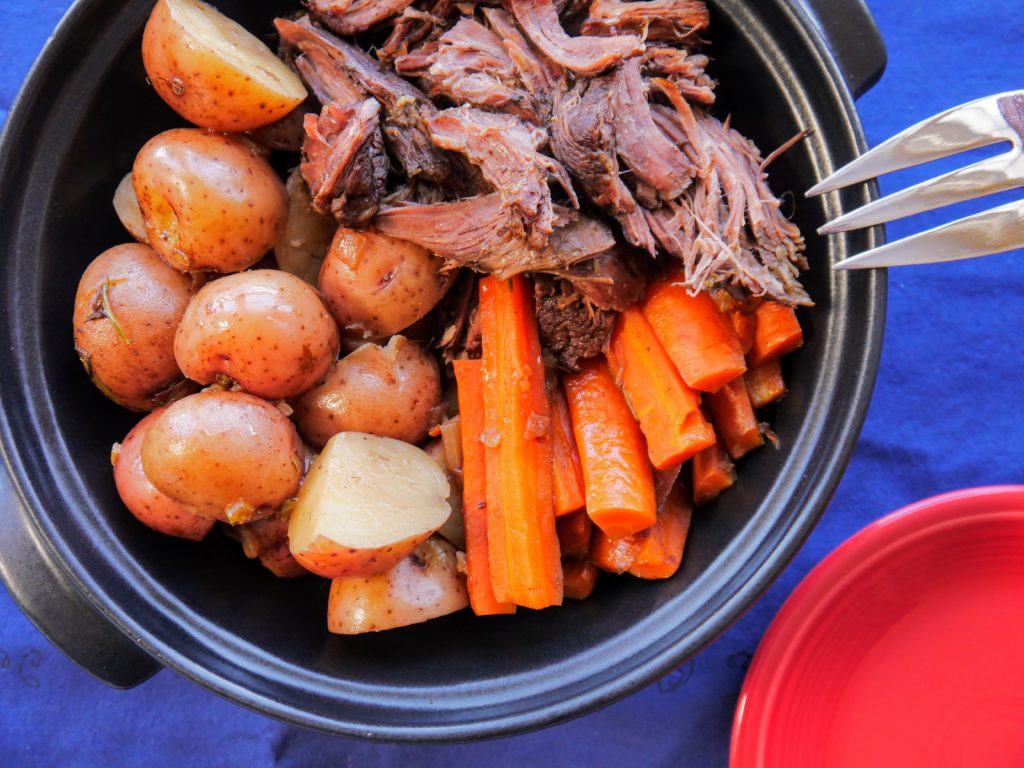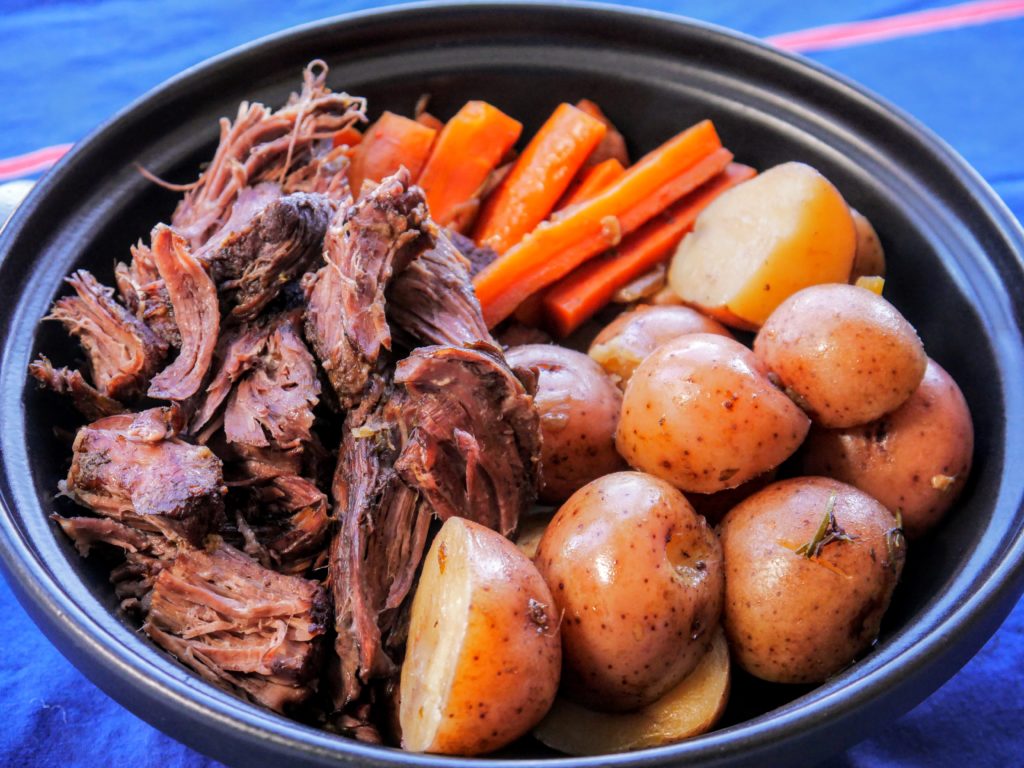
Few foods are as synonymous with a place as pot roast is with the Midwest. It was ubiquitous in the middle-class Christian milieu I grew up in, so much that I would almost guarantee that on any given night, someone within a five-mile radius of my family’s home was making it. Pot roast is Midwest through and through, and for years I ate it without every giving it much thought.
I was hardly alone in my lack of attention to Midwestern food. It seems to be that most food writers don’t think about the Midwest either, unless they’re making fun of it. The Midwest is to American cooking what Britain is to European cuisine—a joke or something that sustains you, but nothing to praise. Think about it: almost every other regional cuisine has had its moment (see: the South, the Southwest, California, and the Pacific Northwest), but Midwest cooking seems to be as much of a culinary flyover as the physical states themselves.
I think I know why this is. Midwest food is seen as unexciting and unsexy; it’s the type of food that your grandmother made and few people want to think about their grandmother as being sexy. It lacks the Southwest’s spices or anything to do with avocados; the American culinary narrative is definitive about what Midwestern food is not. What I want to do is talk about what Midwest food is: ingenious, low-intensity ways to turn economy into abundance. Take pot roast, for example. The dish uses relatively inexpensive ingredients—a chuck-eye roast, root vegetables—and requires a minimal amount of prep time but yields just-firm vegetables and fork-tender meat. Call me crazy, call me unsophisticated, but I think that’s something worth boasting about, and maybe even an example of a cuisine whose moment is overdue.

Pot Roast With Root Vegetables
Sources: Slightly adapted from The New Best Recipe
Serves 6–8 hungry people
Active time: 30 minutes; total time ~5 hours
Ingredients:
- 1 or 2 boneless chuck-eye roasts, totaling 3 1/2–4 pounds
- Kitchen twine (optional)
- Vegetable oil
- 1 medium onion, chopped
- 1 small carrot, chopped
- 1 stick of celery, chopped
- 2 medium garlic cloves, minced
- 2 teaspoons sugar
- 1 cup low-sodium chicken broth
- 1 cup low-sodium beef broth
- Salt and black pepper, to taste
- 1/2–1 cup water
- 1 1/2 pounds red potatoes, scrubbed and cut in half if larger than 1 1/2-inchs in diameter
- 1 1/2 pounds carrots and/or parsnips, scrubbed and cut into sticks
- 1/4 cup dry red wine
- 1 sprig fresh rosemary
Directions:
- Put an oven rack in the middle of your oven, then preheat it to 300°F.
- While the oven is warming up, take a look at your meat. If there are clear chunks of fat running through it—not marbling, which is good, but big veins of it—I like to cut out the majority of the fat. If you can do this while keeping the roast in one piece, do that; alternatively, you can cut the roast into smaller pieces as you trim it. The final product won’t present as nicely, if you’re planning to carve it at the table, but it will still be delicious.
- If desired, use the twine to tie your roast into a neat package. This isn’t necessary, but it will keep the roast from falling apart while it cooks.
- Set a Dutch oven over medium-high heat. When it’s hot, add enough oil to lightly coat the bottom. Add the roast and sear on each side until its nicely browned. You may need to do this in batches, if you cut your roast into pieces or have more than one.
- Pro tip: Adjust the heat as necessary so that the oil doesn’t get too hot and set off your smoke alarm. I speak from personal experience here people.
- Once the roast is browned, remove it to a plate and set aside. Reduce the heat under the Dutch oven and add a splash more veg oil, if needed, before tossing in the onion, carrot, and celery. Cook, stirring and scraping up any bits of fond from the bottom of the pot, until the onion is turning translucent and the vegetables have softened a bit.
- Add the garlic and sugar and sauté for 30 seconds or so. Pour in the broths and stir, scraping up any additional bits of beef that might be stuck to the pot. Season the liquid with salt and pepper to taste.
- Put the roast back in and add as much water as needed for the liquid to come halfway up the roast (I only needed about 1/2 cup). Bring everything to a simmer, then cover the pot with the lid and put the whole thing in the oven.
- Cook the roast, turning it every 30–60 minutes, until a knife inserted into the meat meets little resistance, about 3 1/2–4 hours. Remove the roast from the oven and take off the lid. If you’re picky about this type of thing, this is an excellent time to strain out the vegetables that were flavoring the cooking liquid. I quite like leaving them in, so I just go ahead and…
- Add the vegetables. Depending on how full your pot is, you may need to take the meat out or just move it from side-to-side while you do so.
- Once you’ve added the veg, put the meat back in, if you took it out, pour in the wine, add the sprig of rosemary, and carefully taste the broth to see whether it has enough salt and pepper. Adjust if necessary.
- Recover the pot and return it to the oven. Cook for another 30 minutes or so, until the vegetables are tender but not mushy.
- Remove the roast from the oven. You can dish up straight from the pot, or if you’re feeling fancy, you can put the roast on a cutting board and tent it with foil for a few minutes. Scoop out the vegetables and put them in a serving bowl, ladling a little extra cooking liquid over them. Carve the meat—which really should be more along the lines of pulling it apart with two forks—and put it in another serving dish, again ladling a little of the stock over them, before serving.
- Note: Pot roast makes excellent leftovers. If you have extra meat, I highly suggest using it as a base in tacos or enchiladas.